MSI GT70 Dragon Edition Notebook Review: Haswell and the GTX 780M
by Dustin Sklavos on June 18, 2013 12:01 AM ESTGaming Performance
I had been hoping the MSI GT70 Dragon Edition would be an able demonstration of the performance of Intel's Haswell and NVIDIA's GeForce GTX 780M. While we can isolate the CPU performance easily enough, isolating GPU performance is much trickier. NVIDIA is using boost clocks on the GTX 780M, which means it's able to turbo up depending on thermal and power headroom, and there's actually a healthy enough variation in clocks that different chassis will be able to produce different levels of performance.
There's also the cooling system of the MSI GT70 Dragon Edition, which either doesn't have or just barely has the capacity to handle a combined 150W of heat.
Entry-level gaming results are in Bench, but suffice to say the GTX 780M is more than adequate for those settings, and so for the review I'm going to stick to Mainstream and Enthusiast level benchmarks.
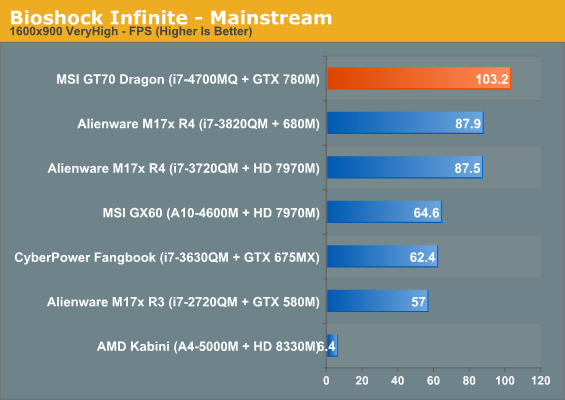

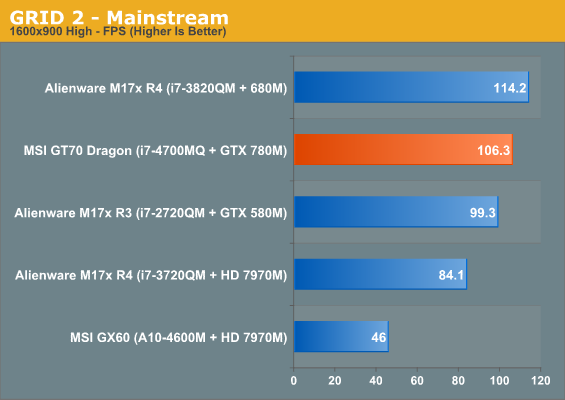
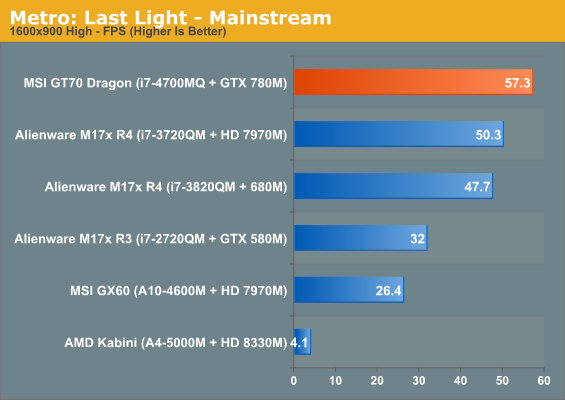
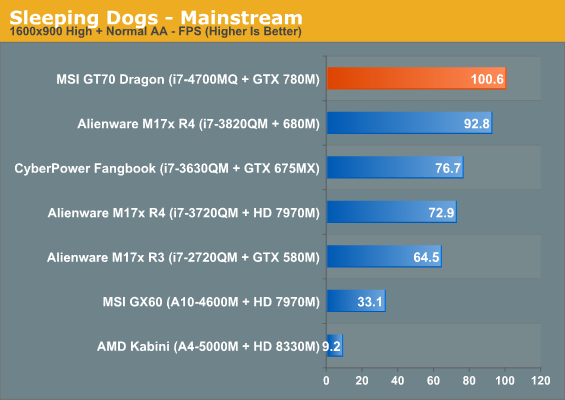
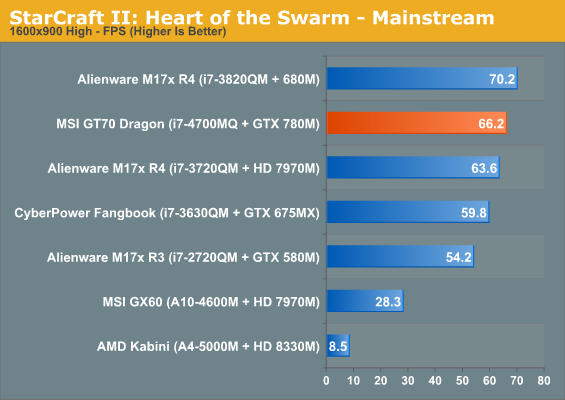

In situations where the CPU is not a limiting factor, the 780M is able to boast a healthy lead on the 680M. But you'll notice that the GT70 Dragon is actually underperforming in certain cases; the CPU is getting throttled due to heat. The superior cooling system of the Alienware M17x is able to dissipate far more heat than the GT70's is.



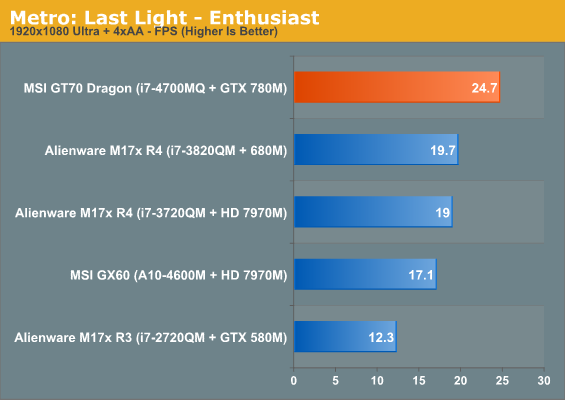
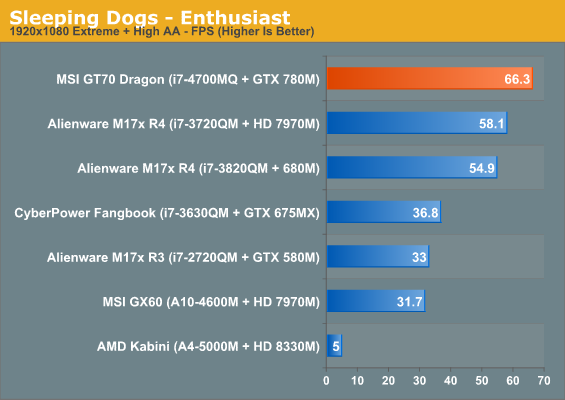
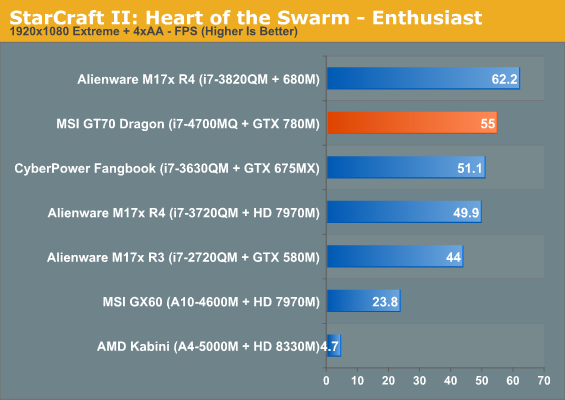
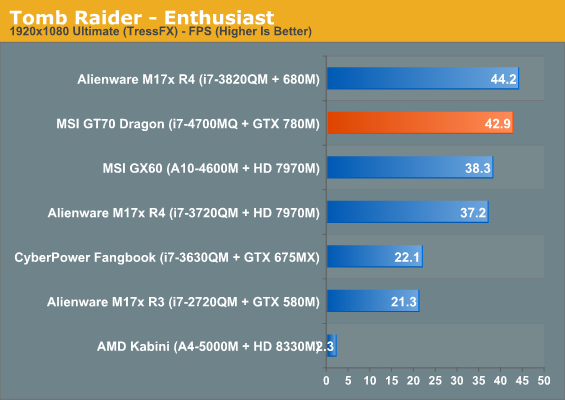
Situations that stress the GPU more exclusively can result in healthy gains over the 680M, but overall stress on the CPU stemming from processor-intensive games like Skyrim and StarCraft II, as well as the hit from TressFX in Tomb Raider, effectively keeps the 780M from really stretching its legs.
Remember that on paper, at stock clocks, the 780M has at least 22% more shader power than the 680M and 39% more memory bandwidth. That means that, bare minimum, the 780M should be roughly 15%-20% faster than its predecessor. We're getting that in the traditionally GPU intensive Sleeping Dogs and Metro: Last Light, and most of it in BioShock: Infinite. But other games see lower gains, or are even slower on the GT70 Dragon Edition despite it having directly superior hardware.










115 Comments
View All Comments
TheinsanegamerN - Thursday, July 11, 2013 - link
the clevo w230st is 13 inch with the hardware power of a fully upgraded alienware 14. and way cheaper too.kallogan - Tuesday, June 18, 2013 - link
INTEL HASFAILhellfish - Tuesday, June 18, 2013 - link
if you read the story its msi fan fail. To quote "Haswell is certainly faster clock for clock"ZeDestructor - Tuesday, June 18, 2013 - link
Optical Drive TSSTCorp SN-506BB Blu-ray writerChuck this out and you have all the space you need for cooling. While keeping room for another HDD or mSATA/mPCI-E SSD Cluster. Seriously, optical media needs to die. ASAP!
Darkstone - Tuesday, June 18, 2013 - link
Dustin, you have to be careful detecting clock speeds. Furmark is the only tool i know that correctly detects graphics card throtteling in every case. For an example, see http://www.notebookcheck.net/fileadmin/Notebooks/S... taken from http://www.notebookcheck.net/Review-Schenker-XMG-P... GPU-z thinks that the GPU is happily running at it's max clock speeds. This is obviously not the case.On the CPU side, CPU-z seems to be unable to detect throtteling in all cases with haswell. See http://www.notebookcheck.net/fileadmin/Notebooks/S... taken from http://www.notebookcheck.net/Review-Schenker-XMG-P... CPU-z states the CPU runs at 2.8Ghz, so does Intel turbo boost monitor. Yet Hardware Monitor measures a package power of 12.63w. No way that is possible on that clock speeds while running 8 threads on prime95. I have personally tested an i7-3820QM under prime95 and it draws around 45W @ 3.2Ghz. Haswell shouldn't be that much more power efficient under load.
MrSpadge - Tuesday, June 18, 2013 - link
Or the power reading is wrong?Crunching BOINC on my HD4000 results in 12 -14 W reported power draw, depending on clock speeds. Yet at the wall I'm drawing 16 - 32 W (1150 - 1350 MHz with adjusted voltage), so it seems those reading simply do not factor supply voltage in, which seems perplexing.
Darkstone - Tuesday, June 18, 2013 - link
The maximum power draw of the HD 3000 is around 12w, or 20w with furmark, those results are not surprising. Intel uses the same sensor to determine when to throttle the processor. My i7-2820QM runs around 2.6Ghz when all 8 threads are stressed, consuming 45w. Under lighter loads the processor still consumes 45w on higher clock speeds.I usually use the Package Power sensor to determine whether the processor is throttling instead of the clock speeds.
Paapaa125 - Tuesday, June 18, 2013 - link
Please include units to upper battery life charts. "229"? Points? Minutes? Hours? What?Meaker10 - Tuesday, June 18, 2013 - link
The fan draws air from the bottom vents (not directly under the fan) and from the keyboard and blows it out the back and side at the same time. It does not suck air through either heatsink.The paste job on your cpu likley needed redoing.
Meaker10 - Tuesday, June 18, 2013 - link
Further cooler boost takes your cpu temps down to 86 at which point you should not see any throttle.The issue may actually be the 180w brick at thwt point.